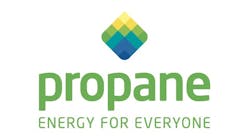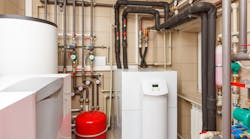Latest from Green
Sloan Achieves WAVE Program Reverification
Sponsored
By Chris North and James DeBerry
It’s been more than one year since the US government signed into law the Inflation Reduction Act of 2022 (IRA), its largest climate investment initiative in the nation’s history. More than $430 billion was invested to spark clean energy innovation, mitigate climate change and lower energy costs for American businesses and homeowners.
The IRA prompted a giant step toward electrification by calling for the reduced reliance of fossil fuels and increased dependence on more environmentally friendly, alternative sources of energy. The IRA is projected to reduce greenhouse gas (GHG) emissions by 31% to 44% below 2005 levels by 2030.
Addressing the amount of energy buildings consume is critical as the transition to a lower-carbon future gets underway. This is especially true since the World Economic Forum reports buildings are responsible for roughly 40% of global energy consumption and approximately 33% of GHG.
By maximizing incentives offered by the IRA, contractors are empowered to drive new commercial and residential business, while helping both groups reduce their carbon footprint and energy bills. There’s no better time for contractors like you to expand your marketing efforts by educating others on IRA tax incentives, cost-saving rebates and programs and implementation of new technology, so they can take part in the electrification movement.
Here are some ideas on how to push electrification forward and take advantage of the monetary savings and benefits.
Spread the Word
Contractors should ensure government community organizations are aware of IRA incentives and tax credits for installing energy-efficient equipment, including all-electric, all-climate heat pumps.
Contact your city and state chambers of commerce along with your local Community Action Agency (CAA)—a non-profit organization responsible for the poverty-fighting Community Action Program (CAP). By educating your CAA and other agencies on the benefits of installing all-electric heat pumps and energy-saving appliances, they can, in turn, pass this information on to consumers and businesses that can benefit from the IRA.
Specific to homeowners, the High Efficiency Electric Home Rebate Program (HEEHRP), a provision of the IRA, allows households making up to 80% of local median income to become eligible to receive a 100% rebate of up to $8,000 on the cost of heat pump installation. Significant extension and expansion of the Energy-Efficient Home Improvement Tax Credit (25C), also part of the IRA, allows qualified households to deduct 30% of the costs for buying and installing a qualified heat pump, up to $2,000 annually through 2032.
Under the IRA’s HOMES Rebate Program—likely to begin late this fall—single and multifamily homes with a:
· 20% energy reduction can get a $2,000 maximum rebate or half the cost of a retrofit project—whichever is less.
· 35% energy reduction are eligible for collect a $4,000 maximum rebate.
· 35% energy reduction and qualifying as lower income—less than 80% of local median income—can receive an $8,000 max rebate.
Be proactive and add IRA incentives to your marketing materials to help pique the interest of homeowners looking for an HVAC upgrade, particularly low- and middle-income households that can benefit the most.
Homeowners aren’t the only ones benefiting from the IRA. For example, the 45L ITC benefits multifamily building contractors that build and sell homes and meet specified energy-efficiency requirements. In doing so, they/you can receive $500 per unit that meets ENERGY STAR standards and $1,000 per unit for zero energy ready units. If certain labor standards are also met, incentives could increase to $2,500 and $5,000, respectively. That’s potential green in your pocket for going green.
Understand New Governmental Guidance
In July, the US Department of Energy (DOE) announced new appliance standards that could save Americans $20 billion over 30 years while cutting down on carbon emissions. Among the advantages, the commercial sector could save $149 million per year for energy-efficient water heaters, while consumers could save $926 million annually for energy-saving pool pumps and boilers.
With so many changes in equipment and appliances, it’s crucial for contractors like you to familiarize yourself with new legislation and consider potential training for those on your teams installing such equipment.
The DOE is now accepting applications for state and territory implementation of the two Home Energy Rebate programs created by the IRA. The DOE has also issued guidance for these governments for the Home Efficiency Rebates and the Home Electrification and Appliance Rebates.
Get Ready for Refrigerant Change
Contractors should be aware, too, that refrigerant changes are underway and will affect HVAC choices soon. The reason? Refrigerant leaks add to fugitive emissions—the release of gases or vapors into the atmosphere that contribute to air pollution and climate warming.
Even though refrigerant leaks are a substantial component of a building's fugitive emissions, refrigerant management is often overlooked as an important part of decarbonization. They should not be ignored.
The US has ratified both the American Innovation and Manufacturing (AIM) Act and the Kigali Amendment, making A2L refrigerants mandatory for most HVAC systems, including heat pump systems, beginning Jan. 1, 2026 for commercial buildings and Jan. 1, 2025 for residential buildings. A2Ls are a class of non-toxic, mildly flammable refrigerants. To meet new global warming potential (GWP) standards, the HVAC industry will change from using traditional high-pressure refrigerants like R410A to A2L classified refrigerants with lower GWP.
Consider Hybrid Variable Refrigerant Flow Solutions
To comply with this part of the decarbonization countdown, HVAC suppliers including Mitsubishi Electric Trane HVAC US (METUS) have introduced Hybrid Variable Refrigerant Flow (HVRF) air-conditioning and heating solutions as additional offerings to standard VRF units. HVRF systems use less refrigerant than conventional VRF solutions and are a key technology in the movement to electrify and decarbonize buildings.
All-electric VRF technology offers a cleaner, more efficient and sustainable way to heat and cool buildings, as they are fossil-fuel-free, reduce HVAC operating costs and improve occupant comfort.
VRF technology divides a building into zones with individual set points based on usage, occupancy and user preferences. Using an INVERTER-driven compressor and continuous fan operation, a VRF system keeps each zone’s temperature steady while consuming minimal energy. Building owners and tenants benefit from low, predictable utility costs, precise comfort control and easier compliance with building codes and local laws restricting building emissions. Choosing a VRF zoning system can also create opportunities to qualify for utility incentives and sustainable building certifications.
Set Yourself Up for Greater Success
As the movement toward electrification progresses, contractors should keep abreast of new and changing legislation. Familiarize yourself with updates to the IRA and other guidance, like recent standards for appliances and refrigerants.
Consider educating local and state agencies as well because in doing so, you can become the “go-to” contractor of choice—one who’s pushing electrification of homes and commercial buildings forward in the name of sustainability—and in the name of maximizing your profits.
Chris North is program manager, Residential Product Marketing, and James DeBerry, is manager, Commercial Marketing, both of Mitsubishi Electric Trane HVAC US.


